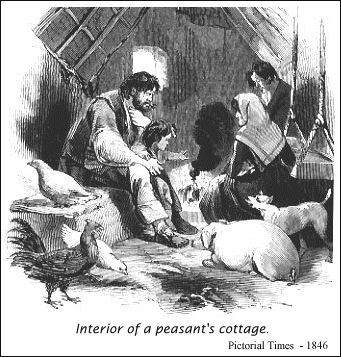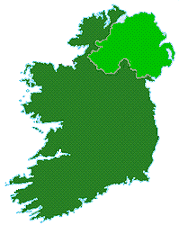IRISH POTATO FAMINE
>> Thursday, February 4, 2010

Introduction
Beginning in 1845 and lasting for six years, the potato famine killed over a million men, women and children in Ireland and caused another million to flee the country.
Ireland in the mid-1800s was an agricultural nation, populated by eight million persons who were among the poorest people in the Western World. Only about a quarter of the population could read and write. Life expectancy was short, just 40 years for men. The Irish married quite young, girls at 16, boys at 17 or 18, and tended to have large families, although infant mortality was also quite high.
A British survey in 1835 found half of the rural families in Ireland living in single-room, windowless mud cabins that didn't have chimneys. The people lived in small communal clusters, known as clachans, spread out among the beautiful countryside. Up to a dozen persons lived inside a cabin, sleeping in straw on the bare ground, sharing the place with the family's pig and chickens. In some cases, mud cabin occupants were actually the dispossessed descendants of Irish estate owners. It was not uncommon for a beggar in Ireland to mention that he was in fact the descendant of an ancient Irish king.
Most of the Irish countryside was owned by an English and Anglo-Irish hereditary ruling class. Many were absentee landlords that set foot on their properties once or twice a year, if at all. Mainly Protestant, they held titles to enormous tracts of land long ago confiscated from native Irish Catholics by British conquerors such as Oliver Cromwell. The landlords often utilized local agents to actually manage their estates while living lavishly in London or in Europe off the rents paid by Catholics for land their ancestors had once owned.
Throughout Ireland, Protestants known as middlemen rented large amounts of land on the various estates then sub-divided the land into smaller holdings which they rented to poor Catholic farmers. The middleman system began in the 1700s and became a major source of misery as they kept sub-dividing estates into smaller and smaller parcels while increasing the rent every year in a practice known as rack-renting.
The average tenant farmer lived at a subsistence level on less than ten acres. These Catholic farmers were usually considered tenants-at-will and could be evicted on short notice at the whim of the landlord, his agent, or middleman. By law, any improvements they made, such as building a stone house, became the property of the landlord. Thus there was never any incentive to upgrade their living conditions.
The tenant farmers often allowed landless laborers, known as cottiers, to live on their farms. The cottiers performed daily chores and helped bring in the annual harvest as payment of rent. In return, they were allowed to build a small cabin and keep their own potato garden to feed their families. Other landless laborers rented small fertilized potato plots from farmers as conacre, with a portion of their potato harvest given up as payment of rent. Poor Irish laborers, more than anyone, became totally dependent on the potato for their existence. They also lived in a state of permanent insecurity with the possibility always looming they might be thrown off their plot.
The most fertile farmland was found in the north and east of Ireland. The more heavily populated south and west featured large wet areas (bog) and rocky soil. Mountains and bogs cover about a third of Ireland. By the mid-1800s, the density of Irish living on cultivated land was about 700 people per square mile, among the highest rate in Europe.
Potatoes are not native to Ireland but likely originated in the Andes Mountains of Peru, South America. In the early 1500s, Spanish conquerors found the Incas growing the vegetable, which the Spanish called patata. They were taken back to Europe and eventually reached England where the name changed to potato. About 1590, potatoes were introduced to Ireland where farmers quickly discovered they thrived in their country's cool moist soil with very little labor. An acre of fertilized potato field could yield up to 12 tons of potatoes, enough to feed a family of six for a year with leftovers going to the family's animals.
By the 1800s, the potato had become the staple crop in the poorest regions. More than three million Irish peasants subsisted solely on the vegetable which is rich in protein, carbohydrates, minerals, and vitamins such as riboflavin, niacin and Vitamin C. It is possible to stay healthy on a diet of potatoes alone. The Irish often drank a little buttermilk with their meal and sometimes used salt, cabbage, and fish as seasoning. Irish peasants were actually healthier than peasants in England or Europe where bread, far less nutritious, was the staple food.
Irish farmers utilized an ancient 'lazy bed' planting technique. Using a simple spade, they first marked long parallel lines in the soil about four feet apart throughout the entire plot. In between the lines, they piled a mixture of manure and crushed seashells then turned over the surrounding sod onto this, leaving the grass turned upside down. Seed potatoes were inserted in-between the overturned grass and the layer of fertilizer then buried with dirt dug-up along the marked lines. The potato bed was thus raised about a foot off the surrounding ground, with good drainage provided via the newly dug parallel trenches.
Planting occurred in the spring beginning around St. Patrick's Day. Most of the poor Irish grew a variety known as Lumpers, a high yielding, but less nutritious potato that didn't mature until September or October. Every year for the poor, July and August were the hungry months as the previous year's crop became inedible and the current crop wasn't quite ready for harvest. This was the yearly 'summer hunger,' also called 'meal months,' referring to oat or barley meal bought from price gauging dealers out of necessity. During the summer hunger, women and children from the poorest families resorted to begging along the roadside while the men sought temporary work in the harvest fields of England.
By autumn, the potatoes were ready to be harvested, carefully stored in pits, and eaten during the long winter into the spring and early summer. The Irish consumed an estimated seven million tons in this way each year. The system worked year after year and the people were sustained as long as the potato crop didn't fail.
NEXT SECTION - Before the Famine
* Before the Famine
* The Blight Begins
* The Great Hunger
* Coffin Ships
* Financial Ruin
* Gone to America
* After the Famine
* Author/Bibliography
0 comments:
Post a Comment